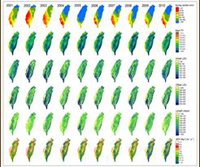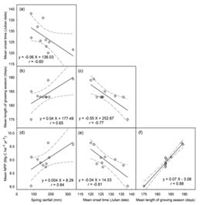

 |
||
|
::: NTU Study on Island Vegetation Onset Time |
||
 The spatial distribution of accumulated spring rainfall (Feb. & Mar.), vegetation coverage, and phonological parameters between 2001 and 2010  Relation between spring rainfall (Feb. & Mar.) and phonological parameters A research team formed by National Taiwan University’s Department of Geography recently published a paper on the Environmental Research Letters, an internationally acclaimed, peer-reviewed scientific journal covering research in all aspects of environmental science. The paper was a study on how the beginning of the growing season (vegetation onset time) in an Asia-Pacific mountainous island affects the productivity of the ecosystem. According to the research, a vegetation’s phenological changes (e.g. leafing, flowering and fruiting) are reflective of the the terrestrial ecosystem’s response to climate change. The paper evaluates the El Nino-Southern Oscillation (ENSO)-associated temporal dynamics of the vegetation onset and its influence on the net primary productivity (NPP) in a subtropical island (Taiwan) of Pacific Asia. The team utilized the decade-long (2001-2010) temporal data derived from the Moderate Resolution Imaging Spectroradiometer (MODIS) to lay out the coverage of green vegetation, and applied the TIMESAT phenology analysis tool to delineate Taiwan’s phenological distribution. According to the findings, when the amount of rain falls below 40 mm during the spring (February to March), the vegetation onset time will be delayed. Such seasonal drought impedes vegetation growth in the subsequent growing season, and it is deduced that this is likely due to the delayed impacts of moisture stress related to preceding ENSO events. There is a strong correlation between the ecosystem’s annual NPP, the vegetation onset time, and the length of the growing season; therefore, the accumulated rainfall during spring may dictate the annual NPP of Taiwan's natural system. As indicated in model simulations, it is forecasted that the frequency and intensity of ENSO-related spring droughts is likely to increase in the future. As a result, this may result in negative effects onto the ecosystem. This research was co-published by Chung-Te Chang (張仲德, postdoctoral researcher), Hsueh-Ching Wang (王雪卿, doctoral candidate) and Cho-Ying Huang (黃倬英, associate professor) of the Department of Geography, National Taiwan University, in the Environmental Research Letters (2013, 8(4), 045030, doi: 10.1088.1748-9326/8/4/045030), and was featured in the Institute of Physics, IOP environmental research web. For more information on the paper, please click HERE. |
||
No. 1, Sec. 4, Roosevelt Road, Taipei, 10617 Taiwan(R.O.C.)
Phone: +886-2-3366-3366 Fax: +886-2-2362-7651